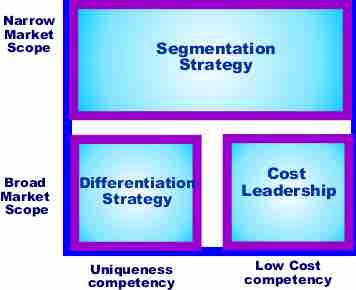Michael Porter described a category scheme consisting of three general types of strategies commonly used by businesses to achieve and maintain competitive advantage. These three strategies are defined along two dimensions: strategic scope and strategic strength. Strategic scope is a demand-side dimension and considers the size and composition of the market the business intends to target. Strategic strength is a supply-side dimension and looks at the strength or core competency of the firm.
Porter identifies two competencies as most important: product differentiation and product cost (efficiency). He originally ranked each of the three dimensions (level of differentiation, relative product cost, and scope of target market) as either low, medium, or high and juxtaposed them in a three-dimensional matrix. That is, the category scheme was displayed as a 3x3x3 cube; however, most of the twenty-seven combinations were not viable.
Cost Leadership, Differentiation, and Market Segmentation
Porter simplified the scheme by reducing it to the three most effective strategies: cost leadership, differentiation, and market segmentation (or focus). He characterizes each as the following:
- Cost leadership pertains to a firm's ability to create economies of scale though extremely efficient operations that produce a large volume. Cost leaders include organizations like Procter & Gamble, Walmart, McDonald's and other large firms generating a high volume of goods that are distributed at a relatively low cost (compared to the competition).
- Differentiation is less tangible and easily defined, yet still represents an extremely effective strategy when properly executed. Differentiation refers to a firm's ability to create a good that is difficult to replicate, thereby fulfilling niche needs. This strategy can include creating a powerful brand image, which allows the organization to sell its products or services at a premium. Coach handbags are a good example of differentiation; the company's margins are high due to the markup on each bag (which mostly covers marketing costs, not production).
- Market segmentation is narrow in scope (both cost leadership and differentiation are relatively broad in scope) and is a cross between the two strategies. Segmentation targets finding specific segments of the market which are not otherwise tapped by larger firms.

Porter's competitive strategies
Porter's three strategies can be defined along two dimensions: strategic scope and strategic strength.
Avoiding the "Hole in the Middle"
Empirical research on the profit impact of marketing strategy indicates that firms with a high market share are often quite profitable, but so are many firms with low market share. The least profitable firms are those with moderate market share. This is sometimes referred to as the "hole-in-the-middle" problem. Porter explains that firms with high market share are successful because they pursue a cost-leadership strategy, and firms with low market share are successful because they employ market segmentation or differentiation to focus on a small but profitable market niche. Firms in the middle are less profitable because of the lack of a viable generic strategy.